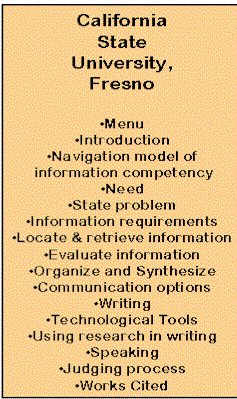
Writing and Information
Competency in Small Bytes
by John A. Cagle and Ross LaBaugh

Technological tools to facilitate writing
Computers of course seem to be everywhere today. They have become so important to education that California State Univesity, Fresno, now has a policy that all students are expected to have personal access to a computer and to the University network. Every year makes it more and more clear that mastering technological skills are essential not only in the educational process, but in the larger public professional world as well.
Several computer programs are fundamental for the research and writing tasks students and professors engage in every day. You will want to get to know what these programs are and how to use them. Fresno State's computer workstation and software recommendations can be found on the Internet at this URL: http://www.csufresno.edu/ait/Access95.htm. The University's Kennel Bookstore has special pricing on most of the basic software you will need as a student, including Microsoft Office (which includes Word, Excel, and PowerPoint, among other things). With the Microsoft Office package, there is a calendar program, by the way, which is useful for keeping track of your classes and planning your study, work, and leisure activities.
Word is a powerful word processing program. Important beginner-level skills for using a word processor include:
- Opening and exiting the program, entering text, opening a file, saving a file, using the find and replace functions, using the spell and grammar checkers, knowing how to cut (or copy) and paste, printing, and inserting pictures or graphics.
- Knowing how to put a header in your document that automatically puts a page number in the proper location.
- Knowing how to use the File / Save As pop-up window to select the location for saving your file (moving to a different directory or to the floppy drive), naming the file, and changing the file format (saving the file as a WordPerfect 6.0 file from the Word 97 program, for example).
- Knowing how to use the outline function.
- Knowing how to switch Views among Normal, Outline, and Page Layout modes of working.
Excel is a powerful spreadsheet program. It gives you the capacity to organize data, manipulate it easily, analyze information (particular such things as statistics), and create tables and graphs of your data for use in writing papers, doing assignments, etc.
PowerPoint is a deceptively powerful presentation program. I say "deceptively" because you can create very impressive presentation slides or overheads the first time you use it, but, beyond ease of use, it has very powerful functions which you will come to value as a student and professional. Its products can be output in many ways--displayed on large screen with a computer, an LCD-panel, and overhead; as 35-mm photographic slides; as printed output in color or black-and-white with one to six slides per page; or as a printed outline. You should learn how to create slides in the slide mode or in the outline mode. You can re-order the slides and add special features (such as transitions and builds) in the slide sort mode. You should learn how to insert, resize, and move graphics or pictures in your slides. Here is an example of the kind of slide PowerPoint can produce for you:
A graphics program such as Photoshop is also an important tool, useful in writing papers, making slides, and creating webpages. Using a scanner (available is many labs on campus), you can make digital copies of photographs, pictures in books and magazines, and so forth. You can capture pictures off the Internet easily and then use a graphics program creatively to make use of the pictures for your purposes.
Many other programs and types of programs are in common use around the University; for example, AutoCAD, Mathematica, and SPSS are three important programs to meet the needs of special disciplines.
Netscape is an excellent web browser and is available free to students; this program is available in all campus computer labs. Microsoft's Internet Explorer is also excellent. Whichever program you like to use, both give excellent access to the Internet. Each enables you additionally to read and use your e-mail, send attachments (such as a Word file to your professor to complete an assignment), save and store your electronic correspondence, etc.
The University offers its own Internet access service (CVIP) for about $9.95 a month. The installation package includes the needed software, including Netscape. You can sign up for the CVIP service either at the Kennel Bookstore or at the CVIP office (which is at the NW corner of Cedar and Barstow).
Links to Previous Competency and to Next Competency
Link to Table of Contents
Communication and
Information Competency in Small Bytes
Menu Introduction
Need State problem Information requirements Locate & retrieve
information Evaluate information Organize
and Synthesize Communication options Writing Technological Tools Using research in writing Speaking Judging process Works Cited
ã 1998 by John A. Cagle, Professor of Communication, California State University, Fresno.
This information competency website was designed by John A. Cagle (Department of Communication) and Ross LaBaugh (Instructional Coordinator, Henry Madden Library) as part of a grant from the California State University. It continues to be under construction.